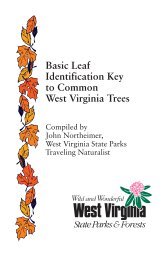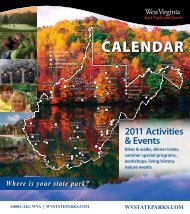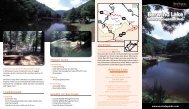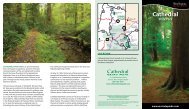Tu-Endie-Wei - West Virginia State Parks
Tu-Endie-Wei - West Virginia State Parks
Tu-Endie-Wei - West Virginia State Parks
You also want an ePaper? Increase the reach of your titles
YUMPU automatically turns print PDFs into web optimized ePapers that Google loves.
LocaTEd in ThE souThErn End of the town of<br />
Point Pleasant (#1 Main Street), four-acre <strong>Tu</strong>-<strong>Endie</strong>-<strong>Wei</strong><br />
state Park commemorates the 1774 engagement. The<br />
park’s centerpiece is an 84-foot granite obelisk that<br />
honors the <strong>Virginia</strong> militiamen who gave their lives<br />
during the battle, while the statue of a frontiersman<br />
stands at the base. Smaller memorial tablets in the park<br />
are dedicated to Cornstalk and to “Mad” Anne Bailey<br />
whose “mad” exploits in thwarting the Indians earned<br />
her the nickname, after her first husband, Richard<br />
Trotter, was killed in the battle. Another interesting<br />
marker rests on the spot where Pierre Joseph de<br />
Celoron de Blainville, a French explorer, buried a leaden<br />
plate in 1749, claiming the land for his country.<br />
PArk SeASON<br />
<strong>Tu</strong>-<strong>Endie</strong>-<strong>Wei</strong> <strong>State</strong> Park is open year-round.<br />
The museum is open from May through October.<br />
Museum hours<br />
Monday through Saturday: 10 a.m. to 4:30 p.m.<br />
Sunday: 1 to 4:30 p.m.<br />
Open holidays.<br />
NeArby ATTrACTIONS<br />
• Beech Fork <strong>State</strong> Park<br />
• Blennerhassett Island Historical <strong>State</strong> Park<br />
• Bob Evans Farm (Rio Grande, Ohio)<br />
• Cedar Lakes FFA-FHA <strong>State</strong> Camp (Ripley)<br />
• Chief Cornstalk Wildlife Management Area<br />
• East Lynn Lake Wildlife Management Area<br />
• Fort Randolph<br />
• Green Bottom Wildlife Management Area<br />
• Huntington Museum of Art<br />
• McClintic Wildlife Management Area<br />
• <strong>West</strong> <strong>Virginia</strong> <strong>State</strong> Farm Museum<br />
OH<br />
<strong>Tu</strong>-<strong>Endie</strong>-<strong>Wei</strong><br />
<strong>State</strong> Park<br />
Ohio<br />
River<br />
35<br />
2<br />
62<br />
LOCATION<br />
New<br />
Lakin Haven<br />
Clinton F. McClintic<br />
Wildlife Management<br />
Area<br />
Letart<br />
Point Pleasant<br />
33<br />
Mason<br />
Henderson Kanawha<br />
Gallipolis<br />
Ferry<br />
River<br />
Arlee<br />
2<br />
35<br />
Leon<br />
Cottageville<br />
87<br />
WV<br />
<strong>Tu</strong>-<strong>Endie</strong>-<strong>Wei</strong> <strong>State</strong> Park is<br />
located in west central<br />
<strong>West</strong> <strong>Virginia</strong>. Point Pleasant lies<br />
one mile north of the junction<br />
of U.S. Route 35 and state Route 2 or at the intersection<br />
of state routes 62 and 2 in Mason County. The park<br />
itself is just west of this intersection at #1 Main Street.<br />
P.O. Box 486<br />
Point Pleasant, <strong>West</strong> <strong>Virginia</strong> 25550<br />
304–675–0869<br />
www.tu-endie-weistatepark.com<br />
<strong>West</strong> <strong>Virginia</strong> Division of Natural Resources, 324 4th Avenue, South Charleston, WV 25303<br />
STATEMENT OF POLICY REGARDING THE EQUAL OPPORTUNITY<br />
TO USE FACILITIES AND PARTICIPATE IN PROGRAMS<br />
Visitors are responsible for observing park rules and regulations.<br />
“It is the policy of the <strong>West</strong> <strong>Virginia</strong> Division of Natural Resources to provide its facilities, accommodations, services and programs to all<br />
persons without regard to gender, race, color, age, religion, national origin or disability. Proper licenses, registration and compliance with<br />
official rules and regulations are the only sources of restrictions for facility use or program participation.”<br />
“The <strong>West</strong> <strong>Virginia</strong> Division of Natural Resources is an equal opportunity employer.”<br />
Information provided in this brochure is current as of design date, but subject to change thereafter. 3/10<br />
62<br />
33<br />
Mt. Alto<br />
2<br />
Evans<br />
68<br />
Ravenswood<br />
62<br />
77<br />
33<br />
Ripley<br />
77<br />
<strong>Tu</strong>-<strong>Endie</strong>-<strong>Wei</strong><br />
<strong>State</strong> Park<br />
www.wvstateparks.com
The bATTLe Of POINT PLeASANT<br />
Here at the confluence of the Kanawha and Ohio<br />
rivers, the bloody, day long Battle of Point Pleasant<br />
was fought. On October 10, 1774, Colonel Andrew<br />
Lewis’ 1,100 <strong>Virginia</strong> militiamen decisively defeated a<br />
like number of Indians led by the Shawnee Chieftain<br />
Cornstalk.<br />
Considered a landmark<br />
in frontier history, some<br />
consider the battle to be<br />
the first of the American<br />
Revolution. This action<br />
broke the power of the<br />
ancient Americans in the<br />
Ohio Valley and quelled a<br />
general Indian war on the<br />
frontier. Significantly, it<br />
also prevented an alliance<br />
between the British and<br />
Indians, one which could<br />
very possibly have caused the Revolution to have a<br />
different outcome, as well as having altered the entire<br />
history of the United <strong>State</strong>s. In addition, the ensuing<br />
peace with the Indians enabled western <strong>Virginia</strong>ns<br />
to return across the Allegheny Mountains to aid<br />
Revolutionary forces.<br />
Battle days: First weekend in October.<br />
When Lord Dunmore (John Murray) was appointed<br />
governor of <strong>Virginia</strong> in 1771, he was ordered to<br />
discourage settlement of the lands beyond the<br />
mountains to the west. This action was motivated in<br />
part by the British government’s desire to pacify the<br />
Indians by preventing encroachment on their hunting<br />
grounds and partly to preserve a profitable fur trade<br />
with the Ohio Valley tribes.<br />
The westward migration proved difficult to halt,<br />
however, as more and more restless settlers poured<br />
over the Alleghenies. The continued invasion aroused<br />
the native population. Their anger turned into<br />
bloody warfare early in 1774 when a group of settlers<br />
murdered the entire family of Logan, a friendly Mingo<br />
chief, opposite the mouth of Yellow Creek in Hancock<br />
County. Logan was so enraged that he led his tribe on<br />
the warpath, he himself taking 30 white scalps and<br />
prisoners in revenge.<br />
Unfortunate clashes between the encroaching<br />
pioneers and the Indians continued with increasing<br />
frequency and savagery. Both whites and red men<br />
were guilty of unthinkable atrocities including murder,<br />
kidnapping and infanticide.<br />
Lord Dunmore ordered<br />
the border militia<br />
organized. Colonel<br />
Andrew Lewis, a<br />
veteran of the French<br />
and Indian War, was<br />
appointed commander<br />
of the <strong>Virginia</strong> troops. By<br />
carrying the fight to the<br />
Indians, Dunmore, a Tory,<br />
hoped to divert <strong>Virginia</strong>ns<br />
from the trouble brewing<br />
with England.<br />
In September 1774, Dunmore signed peace treaties<br />
with the Delaware and Six Nations of the Iroquois at<br />
Pittsburgh. He then started down the Ohio River to<br />
give battle to the fierce Shawnee. Under Cornstalk,<br />
the Shawnee tribe had allied itself with Logan’s Mingo<br />
to turn the frontier “red with Long Knives’ blood.”<br />
Meanwhile Lewis’ army had marched from Fort Union<br />
(Lewisburg) to the point of the confluence of the Great<br />
Kanawha and Ohio rivers. He then established camp to<br />
await Dunmore’s arrival from the north.<br />
This pincer movement was thwarted when Cornstalk<br />
abandoned his Ohio River villages north of Point<br />
Pleasant before Dunmore’s forces arrived. He then<br />
attacked Lewis while the white forces were still divided,<br />
and they engaged in a bloody battle characterized<br />
by a succession of individual hand-to-hand combats.<br />
Fought on this point of land known by the Wyandotte<br />
Indian phrase “tu-endie-wei,” or “the point between<br />
two waters,” the battle raged all day. At times Cornstalk<br />
and his braves held the upper hand, but eventually<br />
the firepower of the backwoodsmen proved superior<br />
on the then heavily forested battlefield. At the end,<br />
230 Indians were killed or wounded and more than 50<br />
<strong>Virginia</strong>ns had lost their lives, including Colonel Charles<br />
Lewis, brother of the commanding officer.<br />
MANSION hOuSe<br />
Located on the park is the Mansion House.<br />
Erected in 1796 by Walter Newman as a tavern,<br />
it is the oldest hewn log house in the Kanawha<br />
Valley. Preserved as a museum, it features<br />
displays of antiques and heirlooms of the era,<br />
including a large square piano believed to be one<br />
of the first brought over the Alleghenies. Two<br />
bedrooms are furnished with authentic fourposter<br />
beds that are more than 150 years old.<br />
Members of the Colonel Charles Lewis Chapter,<br />
N. S. Daughters of the American Revolution<br />
volunteer as available and conduct chapter<br />
meetings at Mansion House Museum.

















